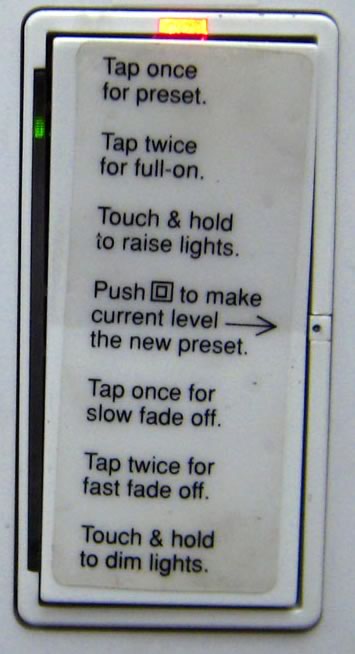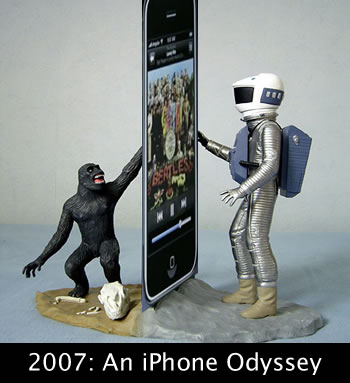Over at the Tucows Blog, I’ve got a podcast in which I interview Adam Eisner, Product Manager for Domains, about his experiences at the recent TRAFFIC conference (“the premier conference for the domain industry”).

Free as in godawful design.
In case you hadn’t heard (or, in case you actually cared), the Free Software Foundation is releasing version 3 of the GPL today. As you might expect, today’s iPhone release is eclipsing GPL v3’s release, but the FSF are undeterred in their mission. In fact, they’re using this coincidence to remind you that the iPhone is a proprietary device with proprietary software created by a proprietary company:
Peter Brown, the executive director of the Boston-based FSF, is also anticipating that the iPhone will include some free software licensed under the GPL. “On June 29, Steve Jobs and Apple will release a product crippled with proprietary software and digital restrictions: crippled, because a device that isn’t under the control of its owner works against the interests of its owner,” he said.
“We know that Apple has built its operating system, OS X, and its Web browser, Safari, using GPL-covered work. It will be interesting to see to what extent the iPhone uses GPL’d software,” he said.
Version 3 of the GPL fights the most recent attempts to take the freedom out of free software, and attacks “Tivoization”—devices that are built with free software but use technical measures to prevent users from making modifications to the software—which could prove to be a problem for Apple and the iPhone, he said.
Of course, if Free Software were the deciding factor for consumers, the GP2X would be the hot ticket in handheld games, not the Nintendo DS. And the hot console would be the…well, the Free Software console that someone will work on, as soon as they’re done with the HURD.
As much as I love and use Free Software, I’ve become quite cynical about its major proponents and figureheads. Whenever I hear someone say “As a card-carrying member of the FSF”, I automatically equate it in my mind with Grampa Simpson’s declartion, “I am not a crackpot!” [MP3 link]

Click the image to hear an MP3 of Grampa Simpson saying “I am not a crackpot!”
 The Ginger Ninja and I had a little time to kill before flying home from Connecticut last Sunday, so we headed over to Borders to get some cheap books.
The Ginger Ninja and I had a little time to kill before flying home from Connecticut last Sunday, so we headed over to Borders to get some cheap books.
Right now, thanks to a combination of:
- A Canadian Dollar that’s relatively strong in comparison to the U.S. Dollar (according to xe.com, it’s 94.22 cents U.S. as of this writing)
- Book jacket prices, which are determined months in advance and are based on the assumption that the Canadian Dollar would be weaker
…it’s far better for us Canadians to buy books in the states.
While at Borders, I saw a display full of Andrew Keen’s The Cult of the Amateur, whose subtitle is How Today’s Internet Is Killing Our Culture, which is covered in today’s New York Times. I had enough time to read the opening chapters and came to my conclusion, an old stand-by for stupid, reactionary works: I’ve seen better paper after wiping my ass.
I plan to write a more detailed review and compare it to David Weinberger’s Everything is Miscellaneous, which I received during my visit to the Berkman Center for Internet and Society at Harvard last week. However, I’m loath to fork over ducats to line Mr. Keen’s pockets, which would only encourage him to keep going. Perhaps one of you has a copy that s/he’d like to sell me?
In lieu of such a review, let me point you to Larry Lessig’s blog entry on it, and more importantly, this comment made in response to said blog entry:
Keen’s a tool. I don’t need to read his book.
What have institutions added to our culture in the last hundred and fifty years?
Nothing.
If they had been running Rodin’s shop they would have thrown out the “mistake” that revolutionized his work. When a plaster model fell over, breaking the arm off, Rodin liked it. And changed art forever.
What has Keen done?
Besides edit and criticize?
Amateurs create signal, institutions mediate it—but can never improve it, only standardize it.
Every time an artist steps into new territory, he or she is, by definition, an amateur. We could quadruple the number of institutions and credentialed practitioners and never gain a single thing culturally, economically, educationally or personally.
This is nothing more than some weird kind of complete self-hatred.
No Sun Ra, no Sex Pistols, No Rolling Stones, no Knut Hamsum, no Pushkin, no Ginsberg — no nobody.
The answer is to stop fixing content prices and allow the market to differentiate itself just like every other market does. We have all the jeans we could ever hope to care about. Why not allow premium content to do the same with movies, books, magazines, music and TV?
It will eventually happen once digital distribution finishes destroying the very institutions Keen is trying to impress.
It’s not a moral question but a economic one.
2007: An iPhone Odyssey
Ain’t it just my luck. As I was whipping up this graphic:
and this graphic:

I decided to do a little Googling and discovered that not only had I been beaten to the punch, I had also been beaten spectacularly, as this iPhone-based spoof of 2001 shows:
Ah well.
Anyhow, all this is preamble for the best advice I’ve seen regarding the iPhone, especially if you’re in the grips of severe technolust (like my friend and coworker James “For the last time, that’s my real name!” Koole, for instance). It’s a piece by Jeff Atwood in his always-excellent blog Coding Horror titled Why You Don’t Want an iPhone — Yet. If you can’t be bothered to read the whole thing, worry not — the meat of the essay is in this line, which I repeat here:
It’s not my goal to crush anyone’s dreams of owning their first iPhone. I know you’ve heard this a million times, but never, never has it been more true for any technology product: wait for version 2.0 before buying.
This goes double for folks like me, who live in Canada (Toronto, a.k.a. Accordion City, in my case). Even if the iPhone were available in Canada today, the data rates here are just so ridiculous that it’s not worth going online with your phone.
So when it comes to all the hype and cajoling to get my paws on an iPhone, my reply, in keeping with the 2001: A Space Odyssey theme of this entry will be…

“I’m sorry, Steve, I’m afraid I can’t do that.”
(Well, not just yet, anyway…)
MMORPGs Build Business Skills?
A study released by IBM and collaboration software maker Seriosity found significant parallels between business leaders and MMPORG gamers.
MMPORG games, which include World of Warcraft, Eve Online and EverQuest, can include millions of players who come together in various groups to accomplish a specific mission or task.
Gamers learn collaboration, self-organization, risk taking, openness, influence and how to earn incentives when involved in a MMPORG, according to a study of 200 members of IBM’s internal gaming community.
“Smart organizations are recognizing valued employees who play online games and apply their skills and experiences as virtual leaders to their ‘real world’ jobs,” says Jim Spohrer, IBM Research Center’s director of services research.
Half of survey participants said playing MMPORGs improved their “real world” leadership skills, while 4 out of 10 surveyed indicated they have applied such game leadership techniques to the workplace.
The survey found that leadership roles are far more fleeting among MMPORG players than in the real world. Leadership is viewed as a role an individual plays to accomplish a specific task, rather than one that remains for an indefinite duration.
I personally know a couple of big-shots who spend a fair bit of time playing World of Warcraft, even when they’re on the road: Joi Ito and my boss’ boss’ boss, Tucows CEO Elliot Noss. Perhaps I should buttonhole fearless leader and see if I can’t get him to do a podcast interview about his adventures on World of Warcraft.
The Dangers of World of Warcraft
I can’t resist including the comic below, The Dangers of World of Warcraft in this article. It’s an old “Dangers of Alcoholism” comic re-jigged to poke fun at people hooked on this very addictive game. Click it to see the full-sized version.

Click the comic to see it at full size.
Comic courtesy of Miss Fipi Lele.
The new trailer for Rockstar’s upcoming Grand Theft Auto IV came out today. I really want this sucker for my birthday!

Click the picture to see the trailer.
I rather like the music for the trailer, but am no longer hip enough to identify it. Can anyone tell me what it is?
John Maeda at The Laws of Simplicity has an interesting photo of a lightswitch at Sun Labs:

Click the photo to see the original.
He writes:
I gave a talk at Sun Labs where I encountered a special light switch in one of their conference rooms. At first I thought it was some kind of silly “engineer” joke. But the light switch functions as stated for real. Does it win the award for the most confusing light switch? I bet there are other ones out there that are equally complex to use.
The lightswitch design philosophy at Sun is quite clearly reflected in Java.

